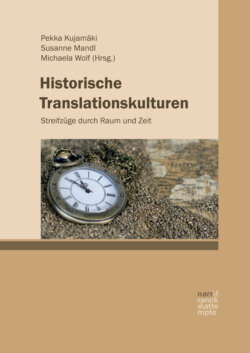Читать книгу Historische Translationskulturen - Группа авторов - Страница 38
3.1 Irish Gaelic
ОглавлениеAs discussed earlier, there are a number of reasons why Ireland has been of particular interest within Translation Studies. As the only Celtic nation to achieve independence, it offers the opportunity today to analyse the role of translation but also language and translation policy in the period of the Celtic Revival which lead up to Irish independence.
The Celtic Revival marks a turning point; until then, translation had been mainly used by the British Empire to colonise Ireland: “Translation […] was a tangible, physical oppression, and it was accompanied by various other forms of dispossession, including the erasure of Ireland’s history and Ireland’s humanity” (Tymoczko 1999: 19). However, translation then was reclaimed by the Irish for their own purposes. A primary function was to make Irish texts available to those who did not speak the Irish language due to the linguistic shift in the nineteenth century (Cronin 2011: 55). Translating thus allowed the revival of the Celtic cultural heritage.
One translator who translated from Irish into English and also published his own works in both languages was Gaelic League founding member and future President of Ireland, Douglas Hyde (Constantine 2009: 298). Hyde’s translations, for example Beside the Fire (1890), a collection of translations of Irish folklore into English, signified a new approach in that the English he used was modelled on the English spoken by most of the Irish (Hyde 1890: xviii). This Irish English was heavily influenced by Irish syntax and idiom and would come to be known as Hiberno-English. Therefore, Hyde’s translation strategy could be described as literal as it retains the lexicon and structure of the source language which still can be recognized when reading Hyde’s translations. His way of translating was groundbreaking as he saw English as a medium he utilized and subordinated to the Irish language in order to draw attention to the “translatedness” of his texts (Constantine 2009: 298). In this way, he reclaimed both translation and language for promoting the Irish language and culture. These translation strategies could be seen as “foreignising”, as suggested by Lawrence Venuti (1995/2008), because they challenged existing power relations.
Lady Gregory, a dramatist and important figure in the Irish Literary Revival, later used the Kiltartan dialect of this new form of English for her translation Cuchulain of Muirthemme (1902) which contributed to Hiberno-English becoming a new literary vernacular for Irish writers (Cronin 1996: 139) such as John Millington Synge, an Irish playwright who was also active as a translator from Gaelic into English (Kiberd 1979: 62–63), and William Butler Yeats, both involved in the Irish Literary Revival.
As can be seen from the examples mentioned above, most of the translations from Irish into English were anthologies containing the translations of old Irish folktales which had previously been translated into English. However, these re-translations were used to “resist and challenge English stereotyping and English cultural isolation. The Irish seized translation of their own cultural heritage as one means of re-establishing and redefining their nation and their people” (Tymoczko 1999: 21). This was also aimed for by translating texts into Irish Gaelic in order to revitalize the language, especially at the beginning of the twentieth century (Cronin 2000: 485).
| Irish Gaelic – Overview What was translated: – More common to translate out of Irish Gaelic – Ancient legends and poetry – Contemporary writers translated themselves Reasons for translation activity: – Revive Irish Gaelic literature and culture – Disseminate Irish Gaelic literature and culture in Ireland and internationally – Recreate the image of Celtic culture – English as the language of the colonisers – Irish should be revived Translation strategies: – Literal translations – “colonise” English – emergence of Hiberno-English – Intralingual translation of legends into modern Irish Translators: – Douglas Hyde – Standish James O’Grady – Lady Gregory – John Millington Synge Aims/Outcomes: – Hiberno-English as a literary vernacular – Interest in contemporary Celtic culture |
